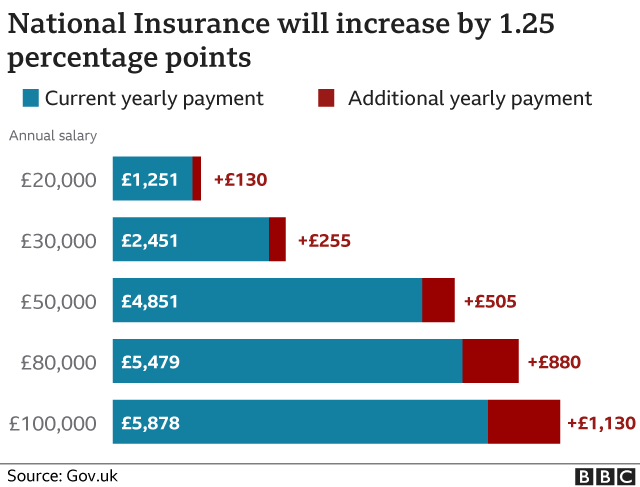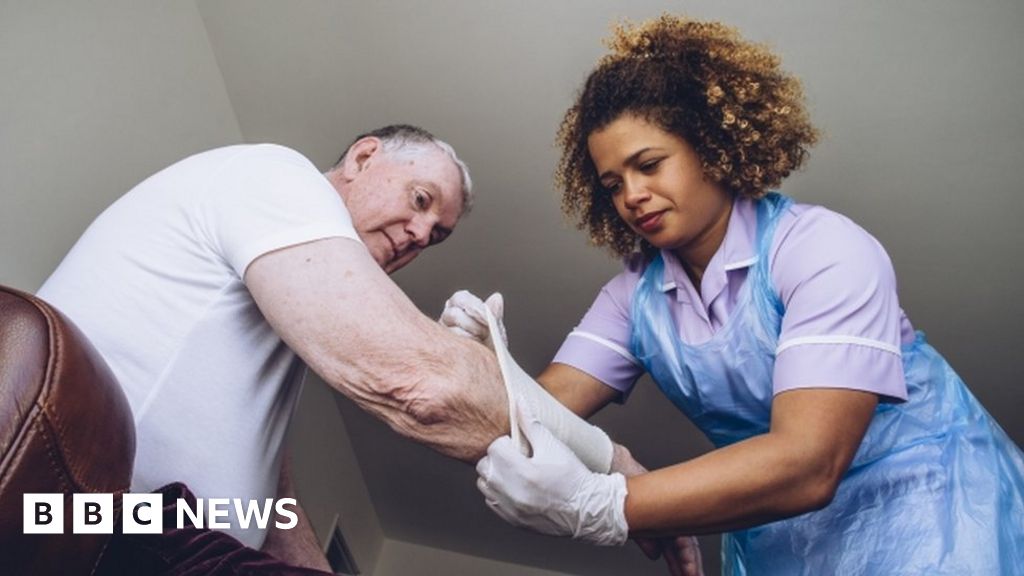A new health and social care tax will be introduced across the UK to pay for reforms to the care sector and NHS funding in England.
Boris Johnson said it would raise £36bn for the NHS and social care in the next three years, including the “biggest catch-up programme in…NHS history”.
He accepted the tax broke a manifesto pledge, but said the “global pandemic was in no one’s manifesto”.
However, Labour leader Sir Keir Starmer said the plan was a “sticking plaster”.
Leaders in social care also warned the money was “nowhere near enough” and would not address current issues in the sector.
The tax will begin as a 1.25 percentage point rise in National Insurance (NI) from April 2022, paid by both employers and workers, and will then become a separate tax on earned income from 2023 – calculated in the same way as NI and appearing on an employee’s payslip.
This will be paid by all working adults, including older workers, and the government says it will be “legally ring-fenced” to only go towards health and social care costs.
Income from share dividends – earned by those who own shares in companies – will also see a 1.25% tax rate increase.
The UK-wide tax will be focused on funding health and social care in England, but Scotland, Wales and Northern Ireland will also receive an additional £2.2bn to spend on their services.
The SNP said the tax would “unfairly penalise Scottish families – and leave the poorest in society subsidising the wealthy”.
MPs will vote on the new proposals in the Commons on Wednesday.
Mr Johnson said the proceeds from the tax would lead to £12bn a year being raised, with the majority going into catching up on the backlog in the NHS created by Covid – increasing hospital capacity and creating space for nine million more appointments, scans and operations.
A portion of the money – £5.3bn over the next three years – will also go towards changes to the social care system, with more promised after that.
A cap will be introduced on care costs from October 2023 of £86,000 over a person’s lifetime.
All people with assets worth less than £20,000 will then have their care fully covered by the state, and those who have between £20,000 and £100,000 in assets will see their care costs subsidised.

Mr Johnson insisted that with the new tax, “everyone will contribute according to their means”, adding: “You can’t fix the Covid backlogs without giving the NHS the money it needs.
“You can’t fix the NHS without fixing social care. You can’t fix social care without removing the fear of losing everything to pay for social care and you can’t fix health and social care without long-term reform.”
But Labour’s Sir Keir said the new tax broke the Conservatives’ pledge at the last election not to raise National Insurance, income tax or VAT.
He also said the rise would target young people, supermarket workers and nurses, rather than those with the “broadest shoulders” who should pay more.
The Labour leader added: “Read my lips – the Tories can never again claim to be the party of low tax.”
The leader of the Liberal Democrats, Sir Ed Davey – who is a carer himself – also said the tax was “unfair”, and that the government’s plan missed out solutions for staffing shortages, care for working age adults and unpaid family carers.
Mr Johnson said no Conservative government wanted to raise taxes – but he defended the move as “the right, reasonable and fair approach” in light of the pandemic, which saw the government spend upwards of £407bn on support.
The IFS said that the announced tax increases – combined with those announced in the Budget earlier this year – totalled the highest tax rises in over 40 years.
Meanwhile, the government has also announced it will suspend the so-called “triple lock” on pensions for one year following concerns that a big post-pandemic rise in average earnings would have led to pensions increasing by 8%.

A tax more palatable to voters?
Analysis by Peter Saull, BBC politics correspondent
Under Boris Johnson’s plan, your payslip will feature a “Health and Social Care Levy” from 2023 onwards.
This is the 1.25% rise in National Insurance rebranded to underline that the money will be ring-fenced for the health and care system.
You may well have seen something similar on your council tax bill.
Local authorities in England have been able to raise extra money through an “adult social care precept” since 2015.
In effect, though, the prime minister is creating a brand new tax.
The idea of a specific “NHS and care tax” is something that may well be more palatable to voters.
And future occupants of No 10 could struggle to justify getting rid of it.

Ahead of the announcement, there was a backlash from number of Tory MPs, who said they were against a rise in National Insurance.
But questioning the PM after his statement in the Commons, many backbenchers instead sought reassurance that the money raised from the new tax would definitely go towards social care.
Former health secretary Jeremy Hunt told BBC Radio 4’s World At One that he thought the government had “listened” to concerns about only making changes to National Insurance, especially as it would “disproportionately target younger people” and not pensioners.
He said: “This new tax is more broadly based and the 10% of pensioners who work will pay it as well.
“It is also extends to dividends as well, so I think it has a broader base, which makes it fairer.”
Mr Hunt said he thought the new tax would pass when MPs vote on it on Wednesday.
‘Sector in meltdown’
However, there was anger from the social care sector over the amount they had been promised as a result of the tax.
Chief executive of the UK Home Care Association, Dr Jane Townson, said: “This is nowhere near enough. It will not address current issues and some measures may create new risks.”
Chairman of the Independent Care Group, Mike Padgham, said it was a “huge opportunity missed for radical, once in a generation reform of the social care system”, adding it would not address the staffing crisis which was “sending the sector into meltdown on a daily basis as care providers struggle to cover shifts”.
And the general secretary of the Unison union, Christina McAnea, said: “A detailed plan is needed first to mend and future-proof a sector broken by years of neglect.
“Only then will the cost of making good the damage become clear.”


It is easy to understand why more money was needed for health and care.
The Covid pandemic has had a huge toll on the NHS, requiring an overhaul of how services are run and creating a growing backlog in care.
Even with this money, it will take the health service years to catch up.
The case for social care predates the pandemic. Governments have been dodging reform of the system since the late 1990s so the changes are being welcomed.
But the introduction of a cap only solves one part of the problem – protecting people’s assets when they face catastrophic costs.
You will still need to be eligible for care to benefit from the cap. Access is rationed so only the most frail qualify – more than half of the requests for help are currently turned down.
Failure to address this, means people could still find themselves paying thousands of pounds a month for care that does not even count towards the cap.
